Types of Coniferous Trees (Including Deciduous Vs. Coniferous Trees)
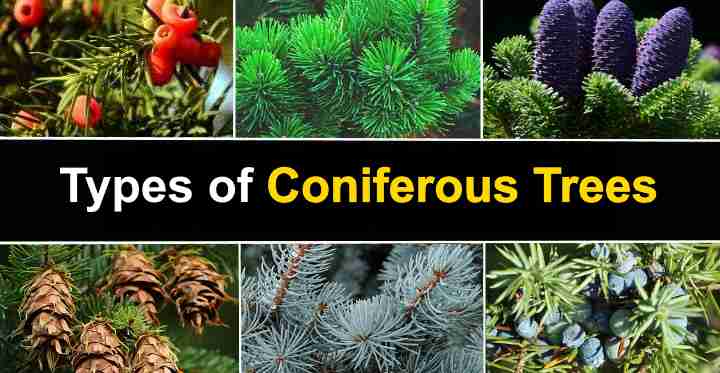
Coniferous trees are types of common softwood trees that are identified by pine-like needle leaves and seed-producing cones. Most types of conifers are evergreen trees, although some conifers are deciduous and lose their leaves in fall. Collectively, coniferous trees belong to the plant class Coniferophyta or Pinophyta. These trees are gymnosperms, meaning they have cone-bearing seeds. There are over six hundred species of conifer trees that are divided into eight families.
The most popular types of conifer trees are: pine trees such as the Scots pine, Douglas fir, and the Eastern white pine. Spruce trees such as the black spruce, Colorado blue spruce, and the Norway Spruce. Then there are fir trees that include evergreens such as the Fraser fir, noble fir tree, and white fir.
It is challenging to distinguish between the various types of conifers. To tell species of evergreen softwoods apart, you need to examine the kind of needle leaves, cones, bark, and shape of the tree. For example, spruce trees have evergreen foliage that is pointed and sharp, whereas firs look similar, but have softer needles.
Types of Coniferous Trees with Their Picture and Name
Let’s look in more detail at some of the most popular types of coniferous trees that grow in forests.
Atlantic White Cedar (Chamaecyparis thyoides)
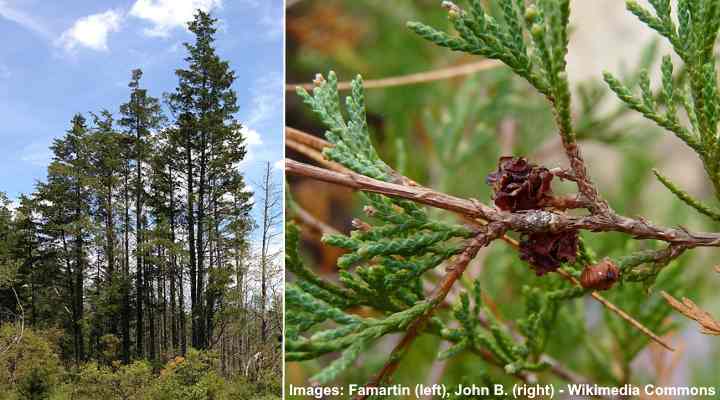
Also known as the Atlantic white cypress or Southern white cedar, this coniferous tree is found along the East Coast of the United States. This cedar features scale-like green or blue-green foliage and round cones.
The majority of the foliage grows at the upper part of the tree, allowing the reddish-brown bark to be clearly visible. These evergreen conifers reach heights between 66 and 92 ft. (20 – 28 m).
Douglas Fir (Pseudotsuga menziesii)
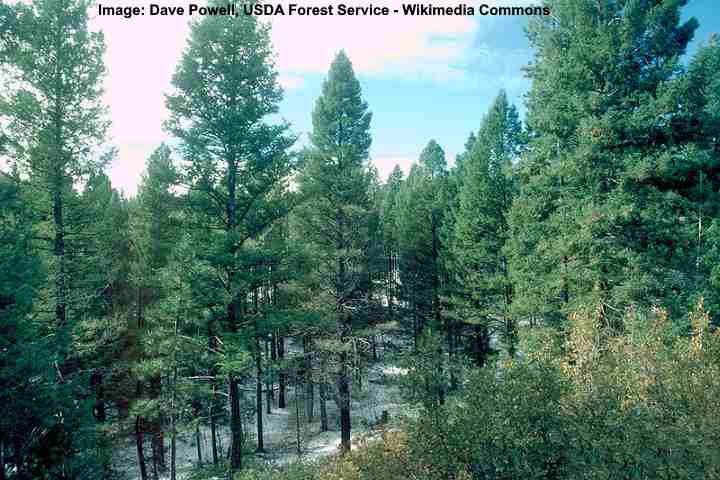
Although called a fir tree, this common conifer species is a member of the pine family. These huge conifers can grow up to 330 ft. (100 m). Douglas fir trees have foliage that more resembles firs than pines.
The needle-leaves are soft and flat and encircle the branches. And, just like all pine trees, the cones dangle down off the branches. Although classed as a type of softwood, the coniferous wood of the Douglas fir is hard and durable. The timber of these conifers is used extensively in the furniture industry.
Lawson’s Cypress (Chamaecyparis lawsoniana)

Also called the Port Orford cedar, this majestic conifer has long straight trunks, feathery foliage, and scale-like leaves. When mature, these cedars can reach heights of 197 ft. (60 m). The seed cones from the conifers are small and globe-shaped. This evergreen tree is also in the false cypress categories of coniferous trees.
Northern White Cedar (Thuja occidentalis)

Also called Arborvitae, Northern white Thuja cedars are ornamental conifer trees with soft feathery dense foliage. When grown in parks, the Northern white cedars grow in a conical shape. Like most trees in the Cupressaceae family, the needle-like leaves are scaly, and they create a fan shape on branches. The seed cones are relatively small.
Alaska cedar (Cupressus nootkatensis)

Another type of false cedar is the Alaska cedar, which is a type of cypress conifer tree. These evergreen coniferous plants have drooping branches, foliage that forms flat sprays, and scale-leaves. Other names for this conifer include Nootka cypress, yellow cypress, and Alaska yellow cedar.
White Spruce (Picea glauca)
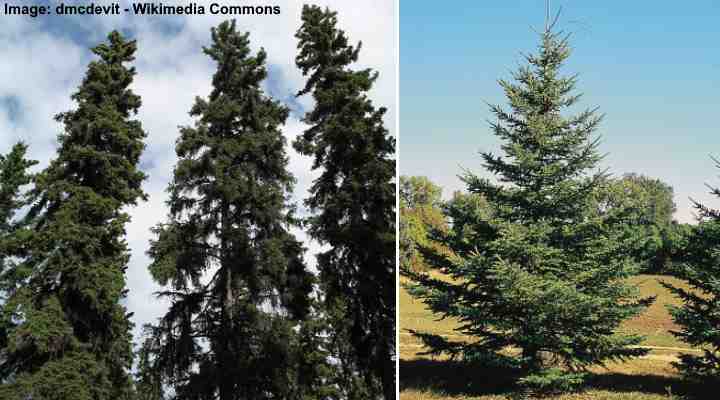
The white spruce is a huge evergreen coniferous tree that is native to cold northern regions. White spruce trees grow to between 50 and 100 ft. (15 to 30 m) tall. These spruce trees have spiky needle-like foliage and produce brown-colored seed cones in the shape of long cylinders. The conifers are identified in forests by their cone-shaped crown.
Black Spruce (Picea mariana)

Like most species of coniferous trees in the genus Picea, black spruce trees thrive in climates that have freezing winters and cool summers. The branches are covered with stiff needles that have a bluish-green appearance. Cones on the black spruce are purple-colored and pendulous. These slow-growing conifers are among the smallest of the spruce varieties.
Colorado Blue Spruce (Picea pungens)
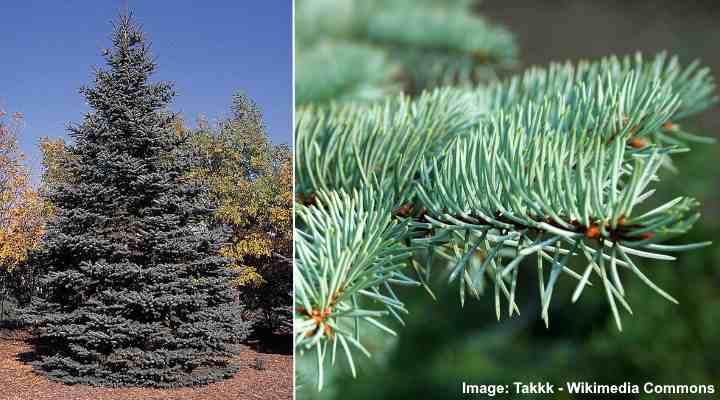
Colorado blue spruce trees are some of the most popular ornamental coniferous trees. The branches grow horizontally and are wider at the bottom than at the top, giving the small tree a distinctly conical shape. The evergreen conifer has blue-green needle leaves that have a spiky feel.
Engelmann Spruce (Picea engelmannii)
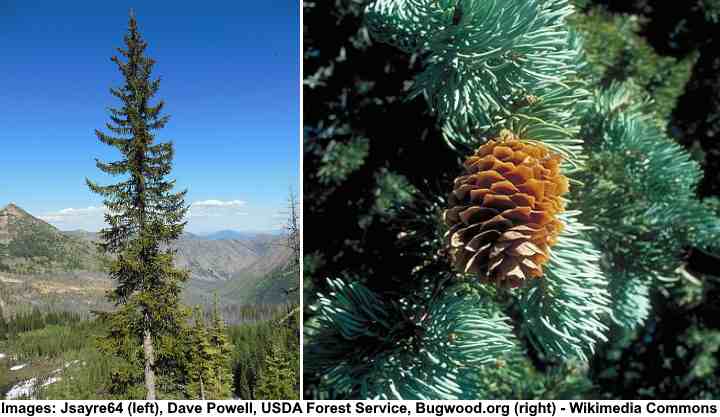
Engelmann spruce trees are conifers that usually grow in the mountains at least 3,000 ft. (900 m) above sea level. The long, slender tree has a tapering shape and branches that grow relatively sparsely up the trunk. Needle-like leaves cover the short stems, and they have a glaucous bluish-green appearance. Cones hang from the branches and have thin scales.
Red Spruce (Picea rubens)
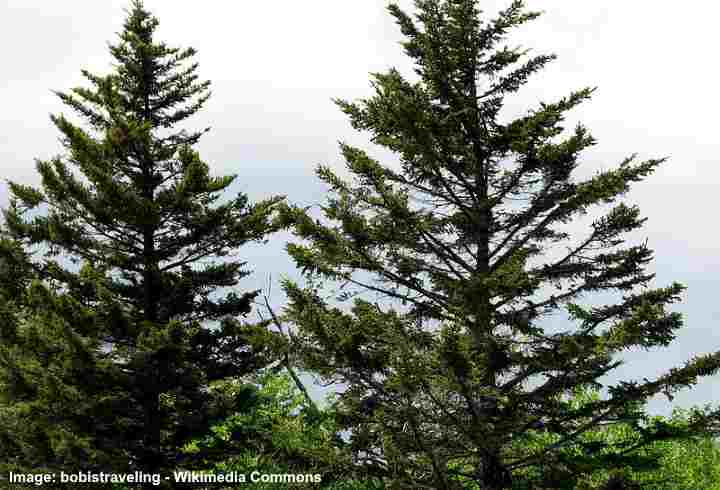
Also called the West Virginia spruce or yellow spruce, this conifer tree has needle-leaves that are a green color with hints of yellow. The spruce tree has reddish bark, which is how it gets its common name. Red spruce cones are hard and stiff in a cylindrical shape and reddish-brown color. Like all spruce trees, the cones are pendulous.
Fraser fir (Abies fraseri)
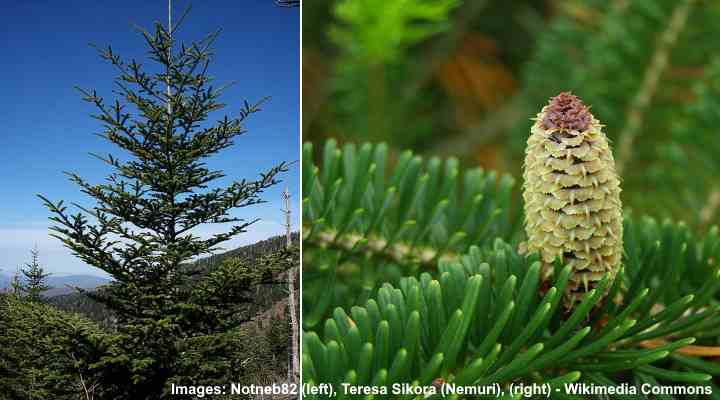
Fraser firs are excellent examples of small coniferous fir trees with a conical shape and green foliage. The spiky-looking needle-covered branches look like spruce needles. However, the difference between fir trees and spruce trees is that fir leaves are much softer. Like most fir trees, you can identify these conifers by their medium-sized cylindrical cones that grow erect.
Grand Fir (Abies grandis)
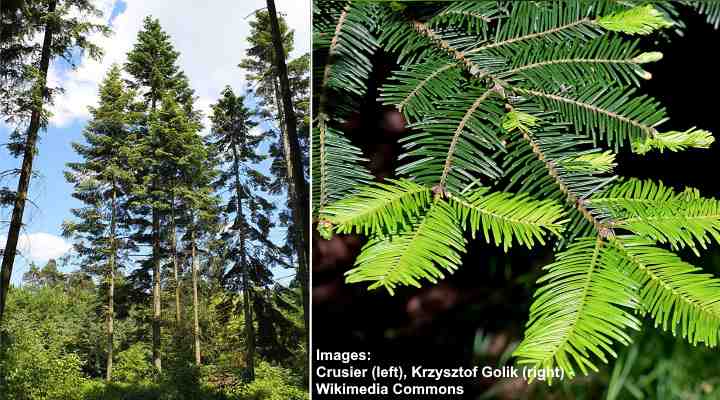
Living up to its name of grand, this majestic fir tree has a conical crown that stretches up to 230 ft. (70 m) high. Grand fir trees are some of the most towering fir trees in the world.
The needle-leaves are flat and shiny green with white stripes on their underside. Cones are lime-green color and a conical oblong shape. In their immature state, grand firs are some of the most popular conifer species to use as Christmas trees.
Pacific Silver Fir (Abies amabilis)
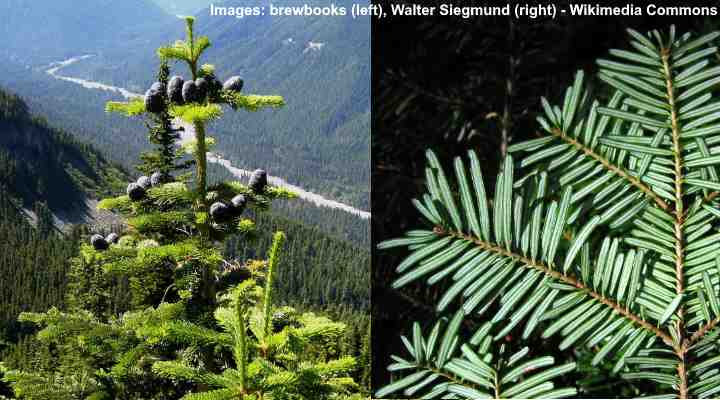
Similar to the grand fir—although not as large—the Pacific silver fir tree has flattened needle-leaves that are matte dark green on the topside and white on the underside.
The lumber of these conifers is not good quality, so the coniferous wood is used in the paper industry. Pacific silver firs are also highly decorative and are used as Christmas trees and in parks.
Eastern Larch (Larix laricina)
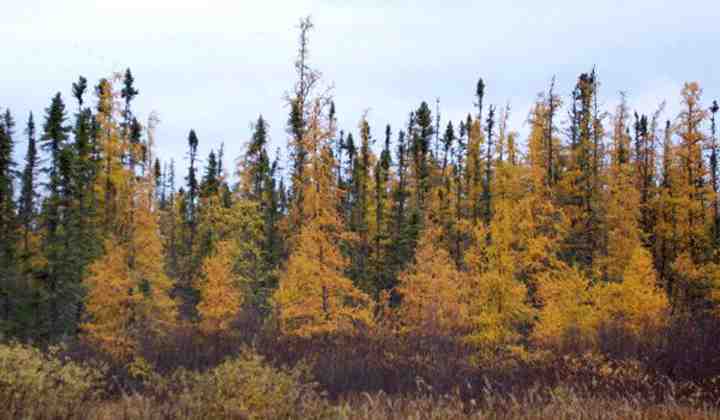
Also called the tamarack, black larch, or American larch, this deciduous conifer tree is native to North America. The needle-like leaves grow sparsely on the branches and are a light bluish-green color.
These deciduous trees turn bright yellow in fall before losing their leaves. The unusual seed cones on these conifers resemble red berries or round yellow buds—depending on whether the tree is male or female.
Eastern White Pine Tree (Pinus strobus)

The Eastern white pine is a large coniferous tree species that grows tall and has a wide spread. The term “white pine” comes from the light gray color of the bark that looks almost white. Branches are evenly spaced on the trunk, so this pine tree doesn’t have dense foliage. The fine needles grow in bunches of five and have a blue-green color. Long, slender pine cones dangle from the branches.
Norway Pine (Pinus resinosa)
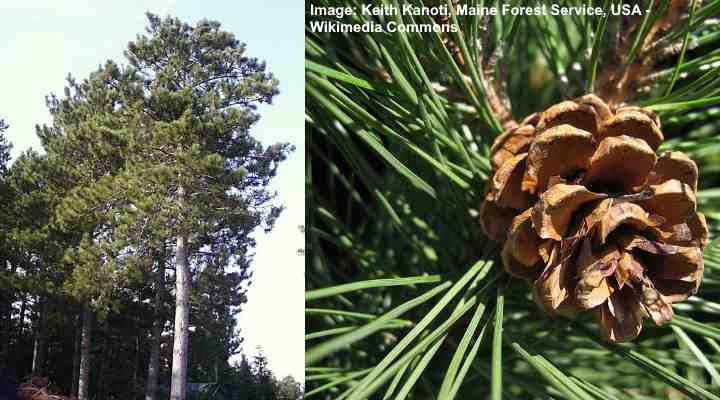
The Norway pine is also called the red pine, and it is a coniferous tree with a slender straight trunk that can grow to 115 ft. (35 m) high. This species of conifer is native to North America, and the common name seems to originate from Scandinavian immigrants. These evergreen trees have needles that grow in bunches of two and have a dark green color. The cones are typical of many pine trees and have an ovoid shape.
Norway Spruce (Picea abies)
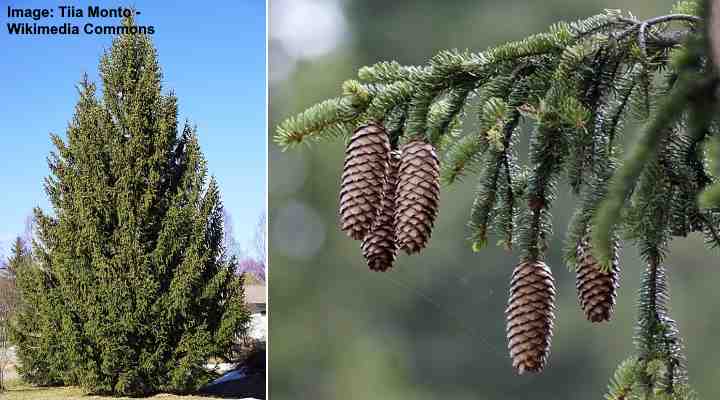
The Norway spruce is a species of conifer that is native to Northern Europe and can withstand cold winters. The upward-pointing branches (fastigiate branches) give the conifer tree a cone shape. It is for this reason that the Norway spruce is one of the most popular conifers to be used for Christmas trees. The spruce conifer has stiff, needle-like leaves that grow around the branches. Like most species of spruce, the elongated oval brown cones dangle down from the branches.
Loblolly pine (Pinus taeda)

Loblolly pines grow in the warmer regions of the world and are characterized by long straight trunks that are branchless for most of their length. The crown-shaped foliage is made up of soft, needle-like leaves that grow in small bunches on the reddish stems. The seed cones have a distinct cone shape and are a green color.
Pinyon Pines (Pinus edulis)
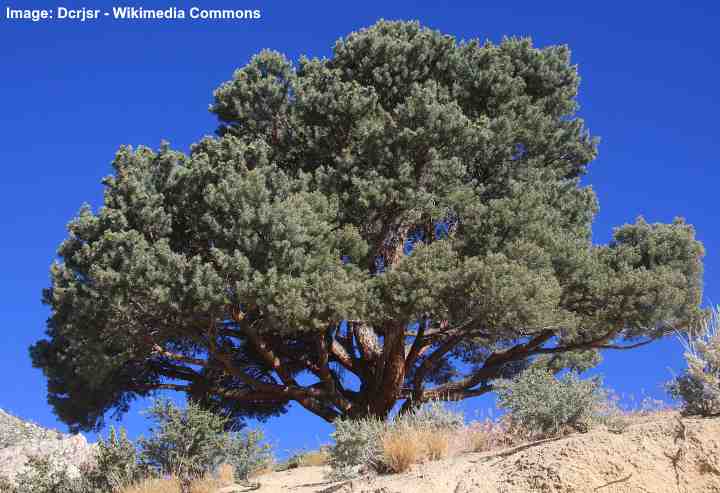
Pinyon pines are famous for the edible nuts that the tree produces—simply known as pine nuts. The distinctive aroma from the wood makes this conifer a popular tree for firewood. The needles grow in bundles of two. This is a small-medium size of this pine tree reaching 33–66 ft. tall (10–20 meters). Pinyon pines are native to hot, dry climates in North America.
Ponderosa Pine (Pinus ponderosa)
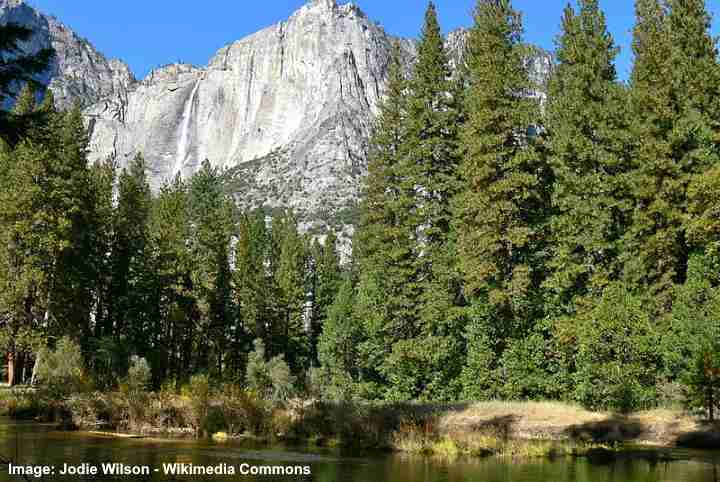
A large type of conifer in the genus Pinus is the Ponderosa pine. The Latin name refers to the dense wood of this coniferous species of tree. Also called the bull pine, blackjack pine, and filipinus pine, this conifer has a long, straight trunk and sagging branches that form a cone-shaped crown. The pine tree has bright-green, stout needles in bunches of three. The smallish pine cones are cylindrical and red.
The Difference Between Deciduous and Coniferous Trees

Most coniferous trees are evergreens but some types of conifers are deciduous
The main difference between coniferous and deciduous trees is the leaf drop in the fall. Generally, deciduous trees have broad leaves that turn yellow, brown, or red in the fall before dropping. Coniferous trees are usually evergreen. However, some conifer species of trees are also deciduous. Let’s look at the difference in more detail.
Deciduous Trees—Trees that shed their leaves when the temperature drops are deciduous—literally meaning they are “falling off at maturity.” Most broadleaf trees, shrubs, and bushes are deciduous and won’t have any leaves during winter. Some trees with needles (conifers) are also deciduous.
Coniferous Trees—Many people use the terms “evergreen” and “coniferous” interchangeably. However, this is not always true. The botanical description of a conifer is a “tree that reproduces via cones.” Most conifers—pine, spruce, fir, and yews—are evergreen. Although they shed their foliage, this happens at different times and the trees appear to be always green, even in winter.
Deciduous Coniferous Trees—Some types of conifers—trees with cone-bearing seeds—lose their leaves. So, coniferous trees such as larches, tamaracks, and dawn redwoods, are types of deciduous conifers. These trees become bare in winter with no needle-foliage on the branches and stems.
Conifer Leaves
Conifers differ from deciduous broadleaved trees because of their needle-like foliage. Some types of conifer leaves on trees such as pine, fir, spruce, and larch have thin leaves that look like needles. Other coniferous plants such as juniper, cypress, and cedar, have soft scale-like leaves. When these conifers shed foliage, it is short branches that drop, not individual leaves.
Conifer Identification
The easiest way to identify different conifer species is to examine their needles. Pines have needles that grow in bundles of two to five needles on a stem. In contrast, spruce trees and fir trees have single needles that grow individually. Identifying the difference between spruce and fir trees is simple. In essence, spruce trees have stiff and sharp needles and fir trees have flexible and soft ones.
As you read about the individual coniferous types of trees, you will find out more about how to identify conifers.
Types of Conifer Trees (Conifer Trees List) – Overview
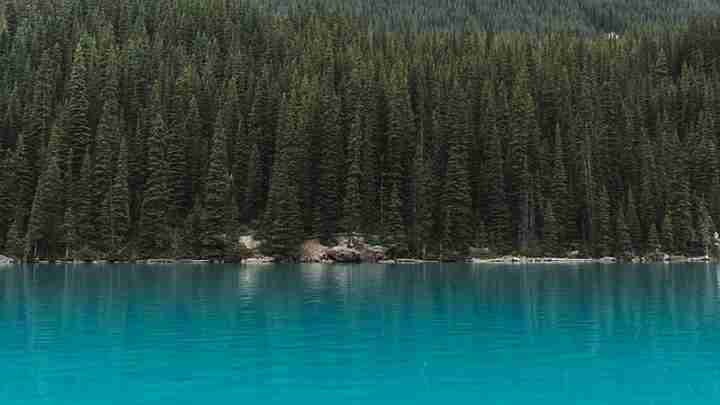
Coniferous forest
Let’s briefly look at the main types of conifer plants that grow in evergreen types of forests. Later in the article, you will find out a lot more information about the most common types of conifers.
Cedars and false cedars
Cedars (Cedrus) are a group of evergreen coniferous trees that have dense clusters of needles. These needles are 1” to 2” (2.5 to 5 cm) long. Cedars also produce barrel-shaped cones that point upward.
False cedars are conifer trees in the Thuja, Calocedrus, and Juniperus genera. Some conifer plants from these genera have “cedar” in their common name; however, they don’t belong to the Cedrus family.
Pine and fir trees
There are over 100 species of pine trees (Pinus), and they have needles that grow in clusters of between two and five. Some species of pines have needles in bundles of seven. Pine cones usually grow in the classic conical shape.
Fir trees (Abies) are related to pine trees and have thin, needle-like leaves. The fir cones are cylindrical and long and stand erect on branches like candles.
Spruce and larch trees
There are around 35 species of spruce trees (Picea), and they have sharp needle-leaves. Visually, spruces look similar to firs. However, their needles are stiffer, and their cones droop.
Larch conifers (Larix) are a type of deciduous conifer tree whose needle-leaf foliage turns yellow in the fall before dropping off. Larch cones are small and oval or egg-shaped.
Cypress and hemlock
Cypress trees (Cupressaceae) generally grow in warmer climates and have sharp, scale-like needles leaves. Cypress cones are woody and leathery and resemble large, plump acorns.
Hemlock conifers (Tsuga) are evergreen conifers that have foliage like short needles growing from small pegs. Hemlock cones are cylinders that range in their length.
Junipers and yews
Juniper conifers (Juniperus) belong to the family Cupressaceae and are known for their intense aroma. Depending on the species, they have needle-like foliage or scale-like foliage. Their cones are like fleshy woody oval fruits.
Yews (Taxaceae) have dark green foliage and pointed soft needle-like leaves. The unique feature of yew trees is that their cones on the female trees look like round red berries.
Redwoods and sequoias
Redwoods and sequoias (Sequoioideae) are some of the tallest trees in the world. Their foliage looks like tiny swords, and they are also sharp. Cones are egg-shaped and are some of the hardest cones from all plants in the family Coniferophyta.
Related articles:
